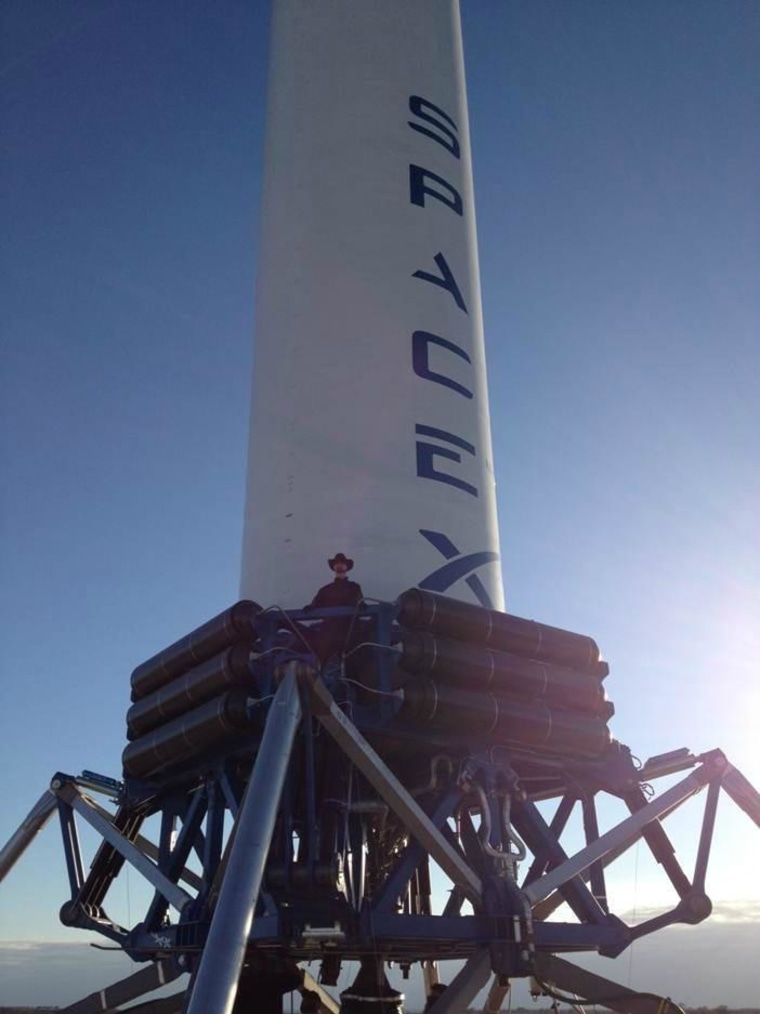SpaceX's prototype Grasshopper rocket took one giant leap last week, rising to a 12-story height and settling back down safely on its landing legs at the company's Texas rocket test facility. Just for fun, the engineers let a dummy cowboy go along for the ride.
The Dec. 17 test flight at the pad in McGregor, Texas, was documented in a YouTube video released today — and discussed in a series of lighthearted tweets from SpaceX's billionaire founder, Elon Musk.
"To provide a little perspective on the size of Grasshopper, we added a 6-ft cowboy to the rocket. ... Then we took him for a ride," Musk wrote. So how did the cowboy fare? "No problemo," said Musk.
The 10-story-tall Grasshopper rocket is designed to take off and land vertically, as part of Musk's plan to develop a rocket capable of returning itself to a launch pad for rapid reusability. Today's vertical-takeoff launch systems generally rely upon expendable lower stages — although the space shuttle's solid rocket boosters could be recovered from the Atlantic Ocean and refurbished for reuse. If a rocket stage can return to its launch facility intact and ready to go again, that could significantly lower the cost of spaceflight. That's what Musk is shooting for.
SpaceX says the Grasshopper consists of a Falcon 9 rocket first stage, a Merlin 1D engine, four steel landing legs with hydraulic dampers, and a steel support structure. During the prototype's first flight test on Sept. 21, the Grasshopper rose 6 feet into the air. The second test, on Nov. 1, lasted 8 seconds and lifted the Grasshopper 17.7 feet (5.4 meters) off the pad. The company said last week's third test went for 29 seconds, during which the Grasshopper rose 131 feet (40 meters) into the air, hovered and landed safely back on the pad, using closed-loop thrust vector and throttle control.

In addition to the Grasshopper, SpaceX is sending its Dragon capsules to resupply the International Space Station, working on a version of the Dragon that could carry astronauts into orbit sometime soon, and developing a Falcon Heavy rocket that could conceivably power flights to the moon. But Musk's long-range goal is even more ambitious: getting settlers to Mars. He has said Grasshopper-style rocket reusability is a key part of that long-term strategy.
"If it does works, it'll be pretty huge," he said last year during a speech at the National Press Club in Washington.
More on the commercial space race:
- SpaceShipTwo straps on its engine
- Golden Spike wants to fly you to the moon ... for $1.4 billion
- Blue Origin's spaceship prototype aces pad-escape test
- Gallery: Ten players in the commercial space race
- Cosmic Log archive on the new space race
Alan Boyle is NBCNews.com's science editor. Connect with the Cosmic Log community by "liking" the log's Facebook page, following @b0yle on Twitter and adding the Cosmic Log page to your Google+ presence. To keep up with Cosmic Log as well as NBCNews.com's other stories about science and space, sign up for the Tech & Science newsletter, delivered to your email in-box every weekday. You can also check out "The Case for Pluto," my book about the controversial dwarf planet and the search for new worlds.